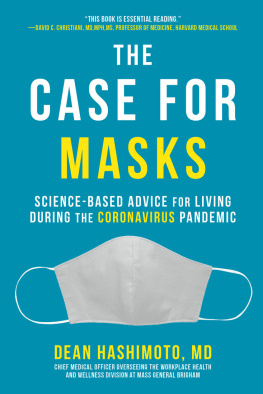Dean Hashimoto - The Case for Masks
Here you can read online Dean Hashimoto - The Case for Masks full text of the book (entire story) in english for free. Download pdf and epub, get meaning, cover and reviews about this ebook. year: 2020, publisher: Skyhorse, genre: Romance novel. Description of the work, (preface) as well as reviews are available. Best literature library LitArk.com created for fans of good reading and offers a wide selection of genres:
Romance novel
Science fiction
Adventure
Detective
Science
History
Home and family
Prose
Art
Politics
Computer
Non-fiction
Religion
Business
Children
Humor
Choose a favorite category and find really read worthwhile books. Enjoy immersion in the world of imagination, feel the emotions of the characters or learn something new for yourself, make an fascinating discovery.
- Book:The Case for Masks
- Author:
- Publisher:Skyhorse
- Genre:
- Year:2020
- Rating:3 / 5
- Favourites:Add to favourites
- Your mark:
- 60
- 1
- 2
- 3
- 4
- 5
The Case for Masks: summary, description and annotation
We offer to read an annotation, description, summary or preface (depends on what the author of the book "The Case for Masks" wrote himself). If you haven't found the necessary information about the book — write in the comments, we will try to find it.
The Case for Masks — read online for free the complete book (whole text) full work
Below is the text of the book, divided by pages. System saving the place of the last page read, allows you to conveniently read the book "The Case for Masks" online for free, without having to search again every time where you left off. Put a bookmark, and you can go to the page where you finished reading at any time.
Font size:
Interval:
Bookmark:



Copyright 2020 by Dean Hashimoto
All rights reserved. No part of this book may be reproduced in any manner without the express written consent of the publisher, except in the case of brief excerpts in critical reviews or articles. All inquiries should be addressed to Skyhorse Publishing, 307 West 36th Street, 11th Floor, New York, NY 10018.
Skyhorse Publishing books may be purchased in bulk at special discounts for sales promotion, corporate gifts, fund-raising, or educational purposes. Special editions can also be created to specifications. For details, contact the Special Sales Department, Skyhorse Publishing, 307 West 36th Street, 11th Floor, New York, NY 10018 or .
Skyhorse and Skyhorse Publishing are registered trademarks of Skyhorse Publishing, Inc., a Delaware corporation.
Visit our website at www.skyhorsepublishing.com.
10 9 8 7 6 5 4 3 2 1
Library of Congress Cataloging-in-Publication Data is available on file.
Cover design by Daniel Brount
Cover image courtesy of Shutterstock
Print ISBN: 978-1-5107-6523-8
Ebook ISBN: 978-1-5107-6556-6
Printed in the United States of America
Contents
Introduction
This book explains why masks are the most important public health tool for controlling the coronavirus pandemic. It describes the scientific research that supports universal masking, including observational studies, population-based analysis, and biosafety studies. It provides practical, science-based guidance for living in the pandemic. This guidance will be invaluable in the short and longer term as the coronavirus is likely to persist for more than the short term and may become endemic, similar to influenza epidemics.
I write this book from the perspective of a physician specializing in workplace health in a large health-care system with more than 75,000 employees. After medical school, I sought specialized medical training in Boston including at the Brigham and Womens Hospital and the Harvard School of Public Health. I began my medical career as a staff physician in the Pulmonary and Critical Care Department at the Massachusetts General Hospital and later specialized in care for the health-care workforce at the Mass General Brigham hospital system, where I am the chief medical officer overseeing the Workplace Health and Wellness division. This division provides clinical services for health-care workers, supports injury and illness prevention programs, and conducts research in association with the Harvard Center for Work, Health, and Wellbeing.
I base this book on the experience of serving in clinical and physician executive roles in protecting the health-care workforce during the coronavirus pandemic. Our hospital systems strategy was highly focused on implementing key CDC guidelines. The danger of trying to reduce all potential health risks to zero is the failure to prioritize the safety interventions that will have the most substantial impact. We took the practical approach of emphasizing key CDC recommendations and implementing them extremely well. Our published study in the Journal of the American Medical Association describes the unexpected high success of the universal masking of health-care workers and patients in our hospital system.
Contrary to the beliefs expressed in the popular media and by some medical experts, I do not think we should entirely rely on the development of a silver bullet that will instantly and magically make the coronavirus pandemic disappear. As I explain in the last chapter, we should not expect vaccinations or drug treatments to necessarily immediately halt this pandemic and its continuing danger and risks. Rather, our best available tool to control the pandemic over the next several years may be based on universal masking. We can diminish this pandemic and normalize our activities if we mask appropriately and regularly wash our hands.
While masks are a key public health tool, this book provides practical science-based advice about related helpful behaviors including social distancing, avoiding high-risk environmental situations, flu shots, and self-isolation if you develop symptoms. This practical how-to advice includes guidance about what types of masks are effective, the best way to wear and fit a mask to your face, special precautions that should be taken for children and in households, as well as safety concerns about masking. These are issues familiar to me, as I have answered literally hundreds of emails from concerned employees and patients.
It is important that science provide the primary guidance for how to live and thrive in the coronavirus pandemic. Scientific knowledge related to the pandemic has developed at a breathtaking rate. Since Chinese researchers published the RNA structure of the coronavirus in January 2020, the scientific knowledge base has expanded rapidly, providing invaluable data for practical application.
Unfortunately, the public has not sufficiently benefited from this scientific and medical knowledge. Instead, theyve become overwhelmed by the constant drumbeat of daily reporting by the public media over the internet. Public leaders have provided conflicting information driven by political considerations. This inconsistency in messaging, along with the evolving nature of scientific research and discovery, has confused the public, as has the preponderance of fake scientific news online.
A problem with modern scientific news is that it is impossible for the public to understand the medical or public health context of particular issues. It is difficult to know what science is important and how much scientific evidence is sufficient to provide guidance on how to live in the coronavirus era. This book provides guidance about a strategy for daily living based on scientific data. It not only provides the science behind the guidance for universal masking, but also more specific information about the types of masks and the environmental context for wearing them. It provides a fundamental understanding of the science so that you can make decisions based on your own individual assessment of your risks and medical vulnerability.
Universal mask wearing is necessary to reduce substantial risks of infection within our communities and borne by individuals. We need to create a new culture of community safety that successfully defines individual boundaries, rights, and responsibilities based on shared scientific understandings. We should develop community standards so we can move forward after reopening our communities and establish a new normality in our social relationships and work practices.
In the first chapter, I describe three striking examples from the pandemic spread that are based on scientific reports of observational studies. Observational studies are fundamental to epidemiological research, particularly in studying the impact of environments on health. In an observational study, the scientific researcher observes individuals to measure associations between exposures in the environment and health outcomes. Such studies may be especially important in studying rare eventssuch as the current coronavirus pandemicwhere collected data can reveal likely associations and their real-world implications.
CHAPTER 1
Stopping the Coronavirus Pandemic: Three Case Studies of Failure and Success
A Choir Practice, March 10, 2020
Next pageFont size:
Interval:
Bookmark:
Similar books «The Case for Masks»
Look at similar books to The Case for Masks. We have selected literature similar in name and meaning in the hope of providing readers with more options to find new, interesting, not yet read works.
Discussion, reviews of the book The Case for Masks and just readers' own opinions. Leave your comments, write what you think about the work, its meaning or the main characters. Specify what exactly you liked and what you didn't like, and why you think so.










